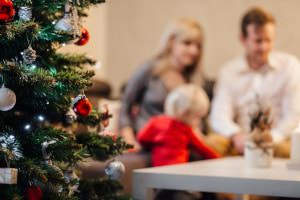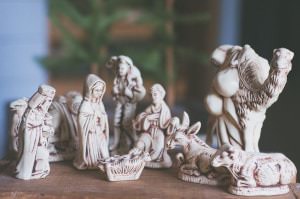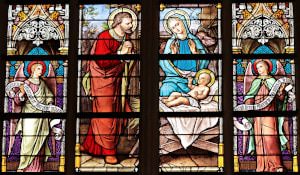 With the increasing popularity of companies like Ancestry and 23andMe, more and more people are finding out just where their family tree has its roots. Sometimes those surnames have everyone fooled. Finding out where you originated is fun; it also opens up opportunities for you and your family to investigate and add authentic holiday customs to your family traditions.
With the increasing popularity of companies like Ancestry and 23andMe, more and more people are finding out just where their family tree has its roots. Sometimes those surnames have everyone fooled. Finding out where you originated is fun; it also opens up opportunities for you and your family to investigate and add authentic holiday customs to your family traditions.
Obviously we can't cover every single country on the planet, so we will only share the Christmastime traditions of a few. Hopefully this will inspire you to seek out your own heritage to enrich and illuminate your annual holiday celebrations.
Many of our customs in the US originated in England, so there are a lot of similarities in how we celebrate Christmas. Christmas cards, decorating with holly and mistletoe, Christmas carols, stockings on the mantle, roast turkey for dinner, presents under the tree all hail from England. A few traditions that are not common in the US are flaming brandy Christmas pudding, containing coins and charms for the kiddies. Flaming Christmas pudding was banned by Oliver Cromwell in the 17th century because he believed it originated in pagan celebrations of the winter solstice. In fact, many of the traditions we associate with Christmas have their beginnings in pagan celebrations, so lighten up Oliver. Fruitcake, that annual butt of jokes, is also popular in England as a Christmas cake, and often features marzipan and icing to sweeten it up.
Christmas crackers, a brightly colored paper tube, which has been twisted at both ends, and contains a small gift of some sort, often accompany the Christmas dinner. They give a loud "pop" when they are opened, hence the "cracker."
Boxing Day, December 26th, is observed by presenting a gift of money or food inside of a box to all those people who make your life easier; delivery people, mail carriers, and other service providers.
 The Nativity "crib" is an essential part of Italian Christmas celebrations. St. Francis popularized this tradition in 1223 by using it to help tell the Christmas story, but it is believed to have its origins 200 years earlier in Naples. While we often display nativity scenes or crèches in the US, the Neapolitan version tends to be much more elaborate and inclusive, featuring everyday people and objects, food, even famous people and politicians. Christmas Cribs are displayed on the 8th of December, leaving out the baby Jesus figure until Christmas Eve.
The Nativity "crib" is an essential part of Italian Christmas celebrations. St. Francis popularized this tradition in 1223 by using it to help tell the Christmas story, but it is believed to have its origins 200 years earlier in Naples. While we often display nativity scenes or crèches in the US, the Neapolitan version tends to be much more elaborate and inclusive, featuring everyday people and objects, food, even famous people and politicians. Christmas Cribs are displayed on the 8th of December, leaving out the baby Jesus figure until Christmas Eve.
Another Italian custom; no meat (and sometimes no dairy) on Christmas Eve; fish is the traditional meal. The Feast of the Seven Fishes, which originated in Southern Italy, features salted cod, clams, calamari, sardines and eel. The Feast of the Seven Fishes is said to represent the seven holy sacraments of the Catholic church. After midnight mass you might enjoy a slice of Panettone, another type of fruit cake.
Epiphany (January 6) is also an important part of the Italian Christmas tradition; this is where the presents come in. Some children believe that "Befana" (an old lady) fills their stockings. In Northern Italy, the Three Kings of the Christmas story might bring you a present instead.
Midnight mass (aka The Mass of the Rooster, or La Misa Del Gallo) is very popular in Spain. The name derives from the belief that a rooster crowed the night that Jesus was born. Most in Spain eat their holiday meal on Christmas Eve before attending church. As it is in Italy, seafood is popular for this Spanish meal. Desserts include mazapán, turrón, and polvorones.
Also as in Italy, most presents come at Epiphany, when the Three Kings show up. Spanish children may write letters to the Kings, telling them what they want. On the eve of Epiphany, which is January 5, the children leave their shoes out to be filled with presents. No cookies for the Three Kings; children leave out a glass of cognac instead.
In Sweden, the celebrations also take place on Christmas Eve. The main holiday meal is often a buffet (or julbord) eaten at lunchtime. On this buffet you may find herring, gravlax (salmon cured in salt, dill and sugar) and smoked salmon, cold turkey, roast beef, ham (julskinka), an assortment of cheeses, pate, salads, and a variety of bread. But it doesn't stop there! You may also find meatballs, sausages, cabbage rolls, lutfisk (dried cod), vegetables...its a big meal. Dessert might be some pepparkakor biscuits6 and pastries. And to drink, a big glass of "glogg" - a mulled wine. After this huge meal, you might watch the Disney special "From All of Us to All of You" featuring Donald Duck. This has aired every year since 1959 at 3 pm on Christmas Eve and half the population of Sweden will tune in.
Presents are normally exchanged on Christmas Eve, followed by church on Christmas morning.
If you have a Swedish heritage, you need a straw goat ornament. The Yule Goat will guard your house and your Christmas tree. And yes, this also has pagan origins.
Many German traditions are an integral part of US celebrations; the Christmas tree, blown glass ornaments, advent calendars and some of our most well-known Christmas hymns like Silent Night (Stille Nacht) and O Christmas Tree (O Tannenbaum) hail from Germany. One tradition that is observed in the US that we think came from Germany is that pickle ornament and its accompanying legend; not German. What is German is a love of angels; these are the most common ornaments and are sold by the thousands in German Christmas markets.
Also found in a German Christmas market is a very popular alcoholic beverage; Germany's version of mulled wine known as Glühwein. You might want to take a little caution with another adult beverage, Feuerzangenbowle. This extremely potent alcoholic drink is set on fire for an added visual bonus.
Enjoy some stollen with that alcohol; it's a traditional German, you guessed it, fruitcake. Filled with fruit, nuts, spices, sometimes marzipan, and then sprinkled with powdered sugar, this fruitcake is actually pretty darn tasty.
Advent is widely observed in Germany; different types of advent calendars are used, including a wreath with 24 decorated bags or boxes hanging from it as well as a wreath with four candles to light at the beginning of each week in Advent.
And the kiddies get their most of their presents on St. Nicholas Day (December 5). This holiday is celebrated by children leaving their boots outside, waking to find them filled with candy, nuts and small gifts. At the same time, on the flip side, there is Krampus putting a cramp on the celebrations. This half-goat, half-demon accompanies St. Nicholas and teaches the naughty children to be nice.
Christmas in the maritime country of Greece is celebrated with a traditional Christmas tree and a boat. Because the first Christmas tree (in 1833) was set up next to a decorated boat, both have become part of Greek holiday customs. Each December an enormous Christmas tree is set up in Aristotelous Square in the city of Thessaloniki (the second largest city in Greece). Three decorated masted ships are also set up alongside it. Boat displays can be found in other large Greek cities, a nod to the old tradition of honoring returned sailors with small ships set up in Greek homes.
The boats carry over into three Christmas celebrations, the morning of Christmas Eve (24th December), the morning of New Year’s Eve (31st December) and the morning of the Eve of Epiphany (5th of January). The tradition is that on these mornings, children in groups go from house to house to sing carols, wishing prosperity and luck to the families. Model boats, painted gold, are carried by the children, along with drums and triangles. The children hope to have their singing rewarded by gifts of money, nuts, and sweets.
Roasted lamb or pork is usually served at the Christmas meal, along with spanakopita (cheese and spinach pie). Baklava, Kataifi and Theeples are eaten for breakfast or as starters to the meal. These pastries feature filo dough, nuts, honey and cinnamon.
A very old tradition in Greek homes is decorating with a shallow wooden bowl. A piece of wire is suspended across the bowl, and a sprig of basil is wrapped around a wooden cross, which hangs from the wire. The daily addition of water to the bowl keeps the basil fresh. Once a day, a family member dips the cross and basil into holy water and sprinkles it in each room of the house. This is to keep away the bad spirits (kallikantzaroi) that come from the center of the earth during the 12 days between Christmas and Epiphany (January 6). Since the spirits come in through the chimney, a fire is traditionally kept burning during those 12 days.
 The main church in the Ukraine is Eastern Orthodox which uses the old "Julian" calendar for church festivals, so they traditionally celebrate Christmas on January 7. Their main Christmas meal, the Holy Supper (Sviata Vecheria) is eaten on Christmas Eve, which is January 6. They fast during the day and do not begin eating the meal until the first star appears in the sky, to honor the journey of the Wise Men.
The main church in the Ukraine is Eastern Orthodox which uses the old "Julian" calendar for church festivals, so they traditionally celebrate Christmas on January 7. Their main Christmas meal, the Holy Supper (Sviata Vecheria) is eaten on Christmas Eve, which is January 6. They fast during the day and do not begin eating the meal until the first star appears in the sky, to honor the journey of the Wise Men.
The Christmas meal often features 12 dishes for each of the 12 disciples. They include kutia14, a wheat porridge, mushrooms, sauerkraut, borsch (beet soup), pierogi, whitefish and kolach, a special bread. No dishes contain meat, eggs or milk.
Like many other countries and Christmas traditions, some celebrations include pagan elements that have been "Christianized." One of these is the Didukh, a table decoration made from a sheaf of wheat. It literally means 'grandfather spirit' and can represent people's ancestors being with them in their memories, but is also said to remind them that Jesus was born in a stable. Sometimes hay is spread under the tablecloth or under the table for the same reason. It is a more modern custom to use heads of wheat in a vase rather than a whole sheaf of wheat.
Decorating with paper snowflakes in the windows and artificial spider webs on the Christmas trees are other Ukrainian traditions. The spider webs are a reminder of the story of The Christmas Spider.
St Nicholas, the patron saint of children, leaves sweets under the pillows of well-behaved children.
Christmas in Ethiopia is centered around the Orthodox churches and their calendar and also falls on January 7. Known as Genna, the Christmas celebration begins on Christmas Eve around 6 pm and can last as late as Christmas morning. Many people travel by foot, going from church to church throughout the night.
The first Christmas meal, which occurs after 43 days of eating only one vegan meal a day, can begin with flaxseed juice to prepare the body for the food to come. This is followed by a spicy chicken stew, doro wot. Later in the day, everyone gathers to enjoy a Genna feast, featuring mutton tips and traditional honey wine or tej.
Giving gifts does not figure highly in the Ethiopian tradition, but buying children new clothing for the celebration is common. Most dress in white in traditional dress called Netela, a simple cotton garment with colorful stripes across the bottom.
Genna shares its name with a Christmas sport; similar to field hockey and played widely during the Christmas season, Genna is said to have originated when the Biblical shepherds were so overwhelmed with joy at the news of Jesus' birth that they used their staffs to break into spontaneous play.
In Chile, Christmas Eve, rather than Christmas Day, is the biggest time for celebration. Friends and extended family gather together for a huge meal around 9 or 10 pm. This meal may include Azuela de Ave (chicken stew) and piles of Pan de Pasqua, bread filled with candied fruit. These are washed down with Rompope and Cola de Mono (Monkey's Tail). After the meal, many families attend midnight mass.
Chileans do a lot of decorating, utilizing lights and balloons and a Christmas tree that is generally set up one or two days prior to Christmas. Nativity scenes are an important part of the decorations and often include small clay or wooden figurines, or pesebre, representing the holy family as well as other religious characters.
There is a Chilean Santa Claus, or Viejito Pascuero, aka Old Man Christmas. He visits every home on Christmas Eve, in a sleigh pulled by, you guessed it, flying reindeer. He also comes down the chimney and leaves presents in stockings and under the tree just like he does in the USA.
Christmas Day is spent relaxing; many people take advantage of the warm weather and head to the beach.
Family Leisure would love to help you create holiday tradtions that have meaning for your family. Whether it's related to your heritage, or just built around something you enjoy, we can help you find the items that bring you together to make memories. Consider the ways a pool table, fire pit, or home theater seating could enrich your family time.
Whatever your heritage, and however you choose to observe the holidays, Family Leisure wishes you Feliz Navidad, Веселого Різдва, Melikam Gena, Buon Natale, God Jul, and Merry Christmas!
No posts found